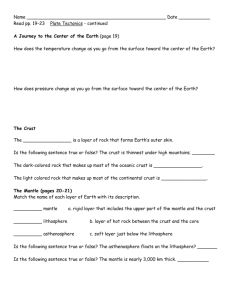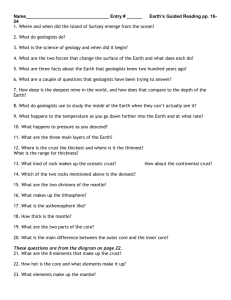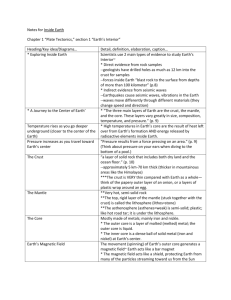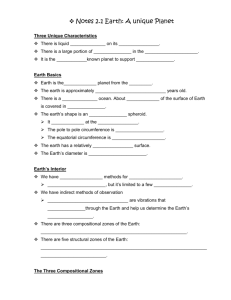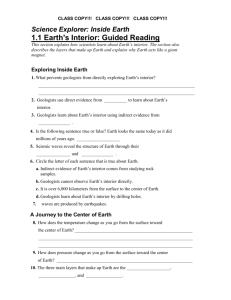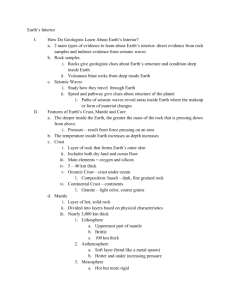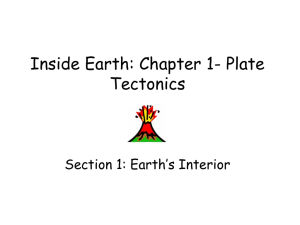chapter 1 section 1 - St. Aloysius School
advertisement
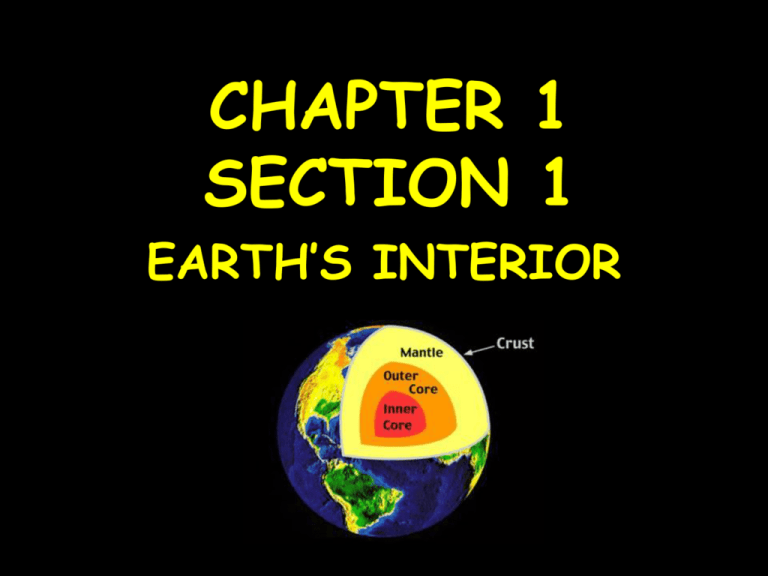
CHAPTER 1 SECTION 1 EARTH’S INTERIOR 1. GEOLOGISTscientists who study the forces that make and shape planet Earth. 2. Geologists study: -CHEMICAL and PHYSICAL characteristics of rock - MAP where different types of rock are found - describe LANDFORMS - study the processes that CREATE Earth’s features and search for clues about EARTH’S HISTORY. 3. ROCK – the material that forms Earth’s hard surface 4. GEOLOGY – the study of planet Earth 5. Geologists have concluded that Earth’s landforms are the result of NATURAL FORCES that slowly build up and WEAR DOWN the land. 6. Geologists divide the forces that change the surface into two groups: CONSTRUCTIVE FORCES – forces that build up mountains and landmasses DESTRUCTIVE FORCES – forces that slowly wear away mountains and other features on the surface. 7. Give one example of a constructive force and one example of a destructive force 8. CONTINENT – a great landmass surrounded by oceans. 9. Why would a geologist study the interior of a cave? TO STUDY MATERIALS THAT ARE NORMALLY UNDERGROUND 10. The EXTREME CONDITIONS of Earth’s interior prevent exploration far below the surface. 11. Geologists must rely on INDIRECT methods of observing Earth’s interior. 12. SEISMIC WAVES – waves produced when earthquakes occur. 13. The SPEED of seismic waves and the PATHS they take reveal how the planet is put together. 14. How is the earth like an onion? IT HAS LAYERS 15. As you go deep toward the center of the Earth TEMPERATURE and PRESSURE increase. 16. PRESSURE – the force pushing on a surface or area. 17. Three main layers make up Earth’s interior: A. CRUST – a layer of rock that forms Earth’s outer skin. - It includes both the dry LAND (where it is thickest under MOUNTAINS) and the OCEAN floor (where it is thinnest) - OCEANIC CRUST – crust beneath the ocean. It consists mainly of dark, dense rocks called BASALT. - CONTINENTAL CRUST –crust that forms the continents. It consists mainly of light colored less dense rock called GRANITE. B. MANTLE – the layer of hot solid rock, located under the crust. - LITHOSPHERE – the rigid layer consisting of the uppermost part of the mantle and the crust together (lithos means “STONE”) - ASTHENOSPHERE – the soft part of the mantle located just below the lithosphere (asthenos means “WEAK”). - The LITHOSPHERE floats on the ASTHENOSPHERE. C. The core consists of two parts. - OUTER CORE – the liquid layer of molten metal – it behaves like a thick liquid. - INNER CORE – a dense ball of solid metal. The metals IRON and NICKEL make up both parts of the core. - The inner and outer cores together are just slightly smaller than the MOON, yet they make up about 1/3 of the Earth’s mass. 18. CURRENTS in the liquid outer core force the solid inner core to spin at a slightly FASTER rate than the rest of the planet. These currents in the outer core create Earth’s MAGNETIC FIELD.


